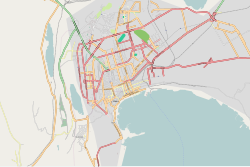The Kerbelayi Abdulla Mosque is a former mosque and historical architectural monument, located at 155 Dilara Aliyeva Street in Baku, the capital city of Azerbaijan. Built in 1894 by philanthropist Abdulla Zerbaliyev, the mosque was included in the list of local significant immovable historical and cultural monuments by the decision No. 132 of the Cabinet of Azerbaijan on August 2, 2001.
| Kerbelayi Abdulla Mosque | |
|---|---|
Azerbaijani: Kərbəlayi Abdulla məscidi | |
 The former mosque in 2018 | |
| Religion | |
| Affiliation | Islam (former) |
| Ecclesiastical or organizational status |
|
| Status |
|
| Location | |
| Location | 155 Dilara Aliyeva Street, Baku |
| Country | Azerbaijan |
Location of the former mosque in Baku | |
| Geographic coordinates | 40°22′31″N 49°50′12″E / 40.3753°N 49.8366°E |
| Architecture | |
| Type | Mosque architecture |
| Funded by | Abdulla Zarbaliyev |
| Completed | 1894 |
| Specifications | |
| Interior area | 170 m2 (1,800 sq ft) |
| Minaret(s) | Two (since dismantled) |
| Materials | Stone |
About
editAccording to the stone inscription on the Kerbelayi Abdulla mosque, the mosque was built in AH 1336 (1917/1918).[1] However, the inscription on the entrance gate indicates the construction date as AH 1311 (1893/1894).[1] The mosque was constructed by philanthropist Abdulla Zerbaliyev, a member of the Baku City Duma.[2][3]
After the Soviet occupation in Azerbaijan, the official campaign against religion began in 1928. In December of the same year, the Central Committee of the Communist Party of Azerbaijan transferred many mosques, churches, and synagogues to the balance of clubs for educational purposes. If there were 3,000 mosques in Azerbaijan in 1917, by 1927, this number decreased to 1,700, and by 1933, it was only 17.[4] The Kerbelayi Abdulla Mosque was also affected during this period, with one of its minarets being used for hanging nearby wet laundry.[5] Another minaret was dismantled. Although the mosque was initially used as a residential building, it later served as a cardboard factory, warehouse, and painting studio for the Russian Drama Theater.[5]
After Azerbaijan regained its independence, the mosque's activities were restored in 1992 through the initiative of the local population.[5] With the decision numbered 132 issued by the Cabinet of Azerbaijan on August 2, 2001, the mosque was included in the list of locally significant immovable historical and cultural monuments.[6]
The "Kerbelayi Abdulla Mosque" registered with the State Committee for Work with Religious Organizations of Azerbaijan, operates as a religious institution.[7]
Architecture
editThe mosque, built of salt stones, lacks both a dome and a minaret, with the two minarets dismantled during the period of Soviet occupation.[1] The entrance to the prayer hall and the women's prayer area is separate and covered with curtains. The prayer hall is 170 m2 (1,800 sq ft).[1]
See also
editReferences
edit- ^ a b c d Azərbaycan Respublikası Məscidlərinin Ensiklopediyası (PDF) (in Azerbaijani). Bakı: Beynəlxalq Əlhuda. 2001. p. 54. ISBN 964-8121-59-1. Archived from the original (PDF) on July 23, 2021.
- ^ Ağamusayeva, Dilarə (2011). Zamanın sorağında (PDF) (in Azerbaijani). Bakı: Elm nəşriyyatı. p. 24. Archived (PDF) from the original on April 6, 2016. Retrieved March 19, 2024.
- ^ Vəlizadə, Tural (2018). Azərbaycanda xeyriyyəçilik ənənələri (in Azerbaijani). Bakı. p. 55. Archived from the original on April 19, 2021. Retrieved March 19, 2024.
{{cite book}}: CS1 maint: location missing publisher (link) - ^ Yunusov, Arif (2004). Ислам в Азербайджане (PDF) (in Russian). Bakı: Zaman. p. 78. ISBN 9952-8052-0-9. Archived (PDF) from the original on July 5, 2023. Retrieved December 14, 2022.
- ^ a b c "Bakı şəhəri Kərbəlayı Abdullah məscidi". sirat.az (in Azerbaijani). January 25, 2022. Archived from the original on October 2, 2023. Retrieved March 19, 2024.
- ^ "Azərbaycan Respublikası Nazirlər Kabinetinin 2001-ci il 2 avqust Tarixli 132 nömrəli qərarı ilə təsdiq edilmişdir" (PDF). mct.gov.az (in Azerbaijani). August 2, 2001. Archived from the original (PDF) on July 7, 2021. Retrieved December 14, 2022.
- ^ "Dini Qurumlar". nasimi-ih.gov.az (in Azerbaijani). Archived from the original on December 5, 2022. Retrieved March 19, 2024.
